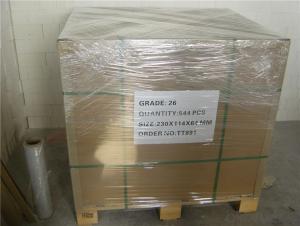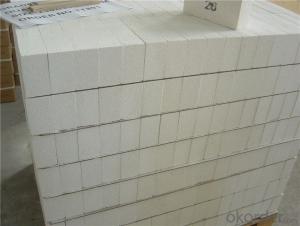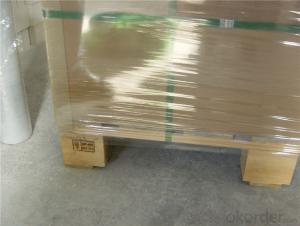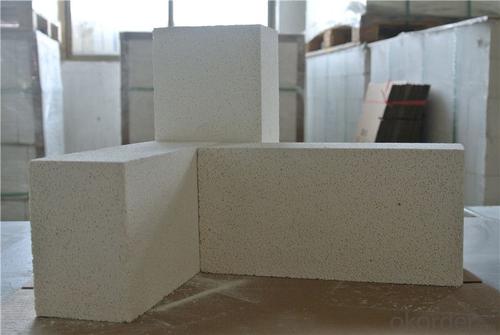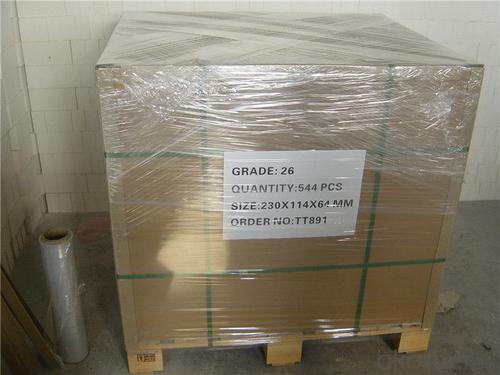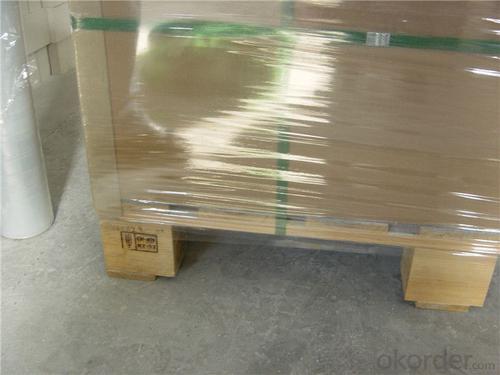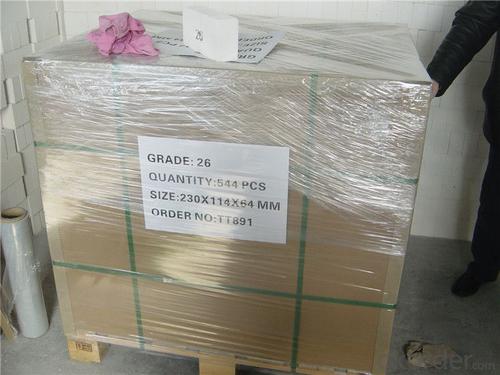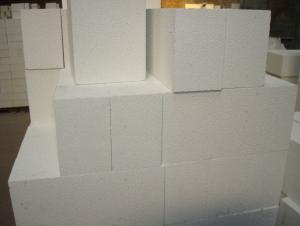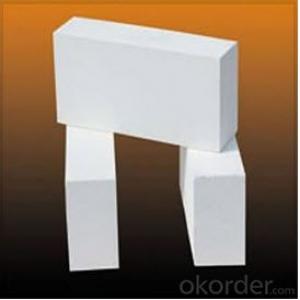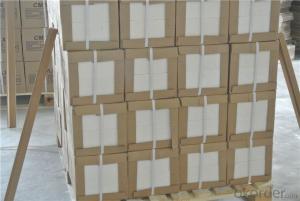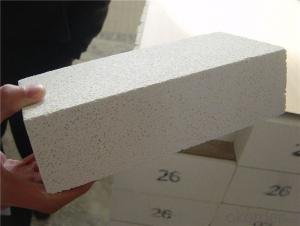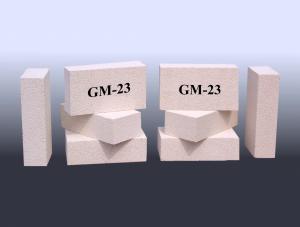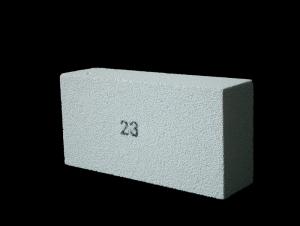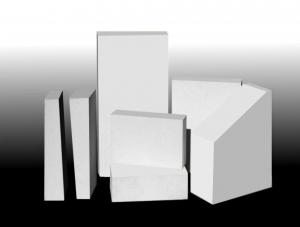Insulating Fire Brick - Refractory Lightweight Insulation Fire Clay Brick for Heating Furnace
- Loading Port:
- Shanghai
- Payment Terms:
- TT OR LC
- Min Order Qty:
- 1 m.t.
- Supply Capability:
- 1000 m.t./month
OKorder Service Pledge
OKorder Financial Service
You Might Also Like
Thermal Insulation Fire Clay Brick
Refractory brick is a block of refractory ceramic material used in lining furnaces, kilns, fireboxes, and fireplaces.
We provide high quality Refractory Fire Bricks that are used on wide range in the various industries like Cement, Glass and Steel. Refractory Fire Bricks are provided as per the quantity and specifications required by the customers. We provide an extensive range of Refractory Fire Bricks at reasonable prices that depend upon the quantity ordered.
Application
Insulating Fire Brick are used for the lining of converter, alternating current arc furnace, direct Current arc furnace and the ladle slag line, etc.
Company Advantage
(1)Long Insulating Fire Brick manufacture history: 25 years manufacturer
(2)Advanced equipment
(3)Diversification of production standards: ISO ANSI FEPA JIS ASTM
(4)Flexible payment: T/T L/C D/P D/A
(5)Professional marketing team and after-sale service
Insulating Fire Brick main feature:
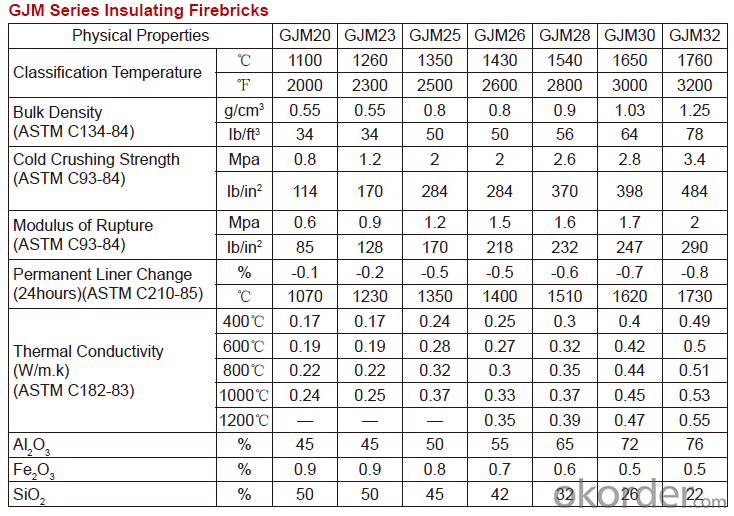
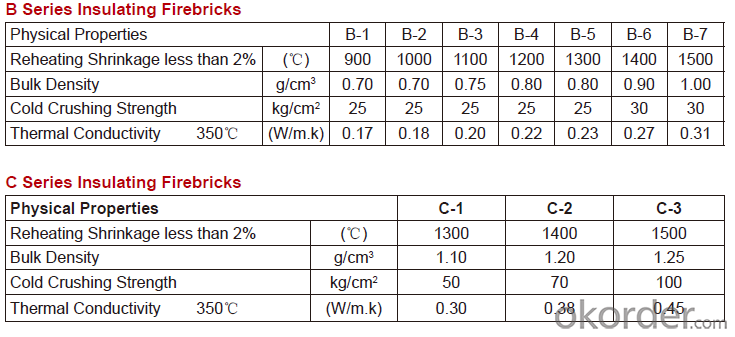
Equipment
1 unit of Ceramic Abrasive (SG Abrasive) pilot production line
2 units of Compact grain Abrasive pilot production lines
1 unit of high-end coated abrasives (abrasive cloth) production line
2 units of Boron Carbide production lines
3 large flexible crushing and sieving lines for grit production lines
6 units of 5000KVA-10000KVA dumping type electric arc furnaces for Brown Fused Alumina fusion
Q1 What’s the transport method?
A1 FCL delivery goods with wooden pallet or wooden case by sea; If LCL delivery, must with wooden case; Sometimes need open top, flat rack or bulk cargo.
Q2 What’s the required payment term?
A2 Generally 30% TT as the prepayment, 70% TT before delivery. If need, 100% Irrevocable Letter of Credit or negotiation.
Q3 Which country are our products exported to?
A3 Apart from entire Chinese market, the US, Russia, Japan, Korea, Australia and some Southeast Asian Nations.
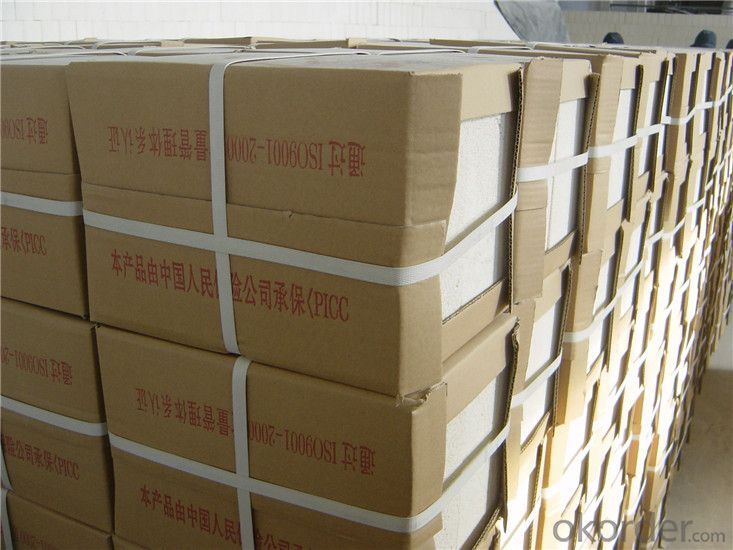

- Q: Are insulating fire bricks suitable for applications requiring low thermal conductivity?
- Insulating fire bricks are a suitable option for applications that require low thermal conductivity. They are specifically designed to possess low thermal conductivity, making them an ideal choice for situations where heat insulation is necessary. These bricks are crafted from lightweight and porous materials, like clay and other refractory materials, which offer exceptional insulation properties. The porous structure of insulating fire bricks captures air within the material, reducing heat transfer and resulting in minimal thermal conductivity. Consequently, they prove to be highly effective in kilns, furnaces, and other high-temperature settings where minimizing heat loss is essential. In summary, insulating fire bricks are a dependable selection for applications that necessitate low thermal conductivity.
- Q: Can insulating fire bricks be used in chimneys or flues?
- It is not advisable to use insulating fire bricks directly in chimneys or flues due to their primary purpose of insulation rather than being a structural component. Chimneys and flues require refractory bricks that are specifically engineered to withstand the intense heat and corrosive byproducts of combustion. These refractory bricks have high thermal resistance and exceptional durability, ensuring the safe and efficient operation of the chimney or flue. Therefore, it is recommended to use refractory bricks instead of insulating fire bricks for construction or repair purposes in chimneys and flues.
- Q: Can insulating fire bricks be used in the construction of pottery ovens?
- Yes, insulating fire bricks can be used in the construction of pottery ovens. Insulating fire bricks are specifically designed to have excellent thermal properties, such as low thermal conductivity and high resistance to heat. These qualities make them ideal for insulating and retaining heat in pottery ovens, allowing for more efficient and controlled firing of clay and ceramic materials. Additionally, insulating fire bricks are lightweight, which makes them easier to handle and install in the construction process. Overall, the use of insulating fire bricks in pottery ovens helps to create a consistent and even distribution of heat, resulting in improved firing outcomes and energy efficiency.
- Q: Are insulating fire bricks suitable for insulation in steam boilers?
- Yes, insulating fire bricks are suitable for insulation in steam boilers. They are designed to withstand high temperatures and provide excellent thermal insulation, making them ideal for use in steam boilers to minimize heat loss and improve energy efficiency.
- Q: How do insulating fire bricks affect the overall carbon footprint of a structure?
- Insulating fire bricks can significantly reduce the carbon footprint of a structure. These bricks have higher thermal insulation properties compared to traditional bricks, which means they can better retain heat and reduce the need for excessive heating or cooling. By improving energy efficiency and reducing the consumption of fossil fuels, insulating fire bricks help to lower the carbon emissions associated with the structure's operation. Additionally, their longer lifespan and recyclability contribute to further environmental benefits by reducing waste generation and the need for frequent replacements, ultimately minimizing the overall carbon footprint of the structure.
- Q: Can insulating fire bricks be used in the construction of boilers for steam generation?
- Yes, insulating fire bricks can be used in the construction of boilers for steam generation. Insulating fire bricks are designed to have low thermal conductivity, which helps to minimize heat loss and improve the overall energy efficiency of the boiler. They are commonly used in the construction of boiler walls, floors, and furnace linings as they can withstand high temperatures and provide excellent insulation properties. By using insulating fire bricks in the construction of boilers, the heat generated by burning fuel can be effectively contained and transferred to the water, resulting in efficient steam generation.
- Q: How do insulating fire bricks help reduce heat loss through convection?
- Insulating fire bricks are specifically designed to minimize heat loss through convection. They achieve this by creating a barrier that prevents the movement of air and heat transfer. These bricks are made from lightweight refractory materials, which have low thermal conductivity. This means that they are not good conductors of heat and do not allow heat to easily pass through them. When these bricks are used in construction, they create a layer of insulation that effectively reduces heat transfer by convection. Convection is the process of heat transfer through the movement of air or fluid particles. The insulating fire bricks act as a barrier, preventing the free flow of air and interrupting the convective currents. The bricks are designed with small, interconnected air pockets or pores, which trap air inside them. These air pockets act as insulators and minimize the transfer of heat by convection. The trapped air forms a stagnant layer, reducing the movement of air and preventing the heat from escaping or entering the area. By reducing heat loss through convection, insulating fire bricks help to maintain a stable and comfortable temperature within a structure. They are commonly used in applications where heat insulation is essential, such as in industrial furnaces, kilns, and fireplaces. These bricks not only enhance energy efficiency by reducing heat loss but also contribute to fire safety by preventing the spread of heat to adjacent areas.
- Q: Can insulating fire bricks be used in the construction of flue liners?
- Yes, insulating fire bricks can be used in the construction of flue liners. Insulating fire bricks are designed to withstand high temperatures and provide excellent insulation properties. These bricks are made from lightweight materials such as vermiculite or perlite, which have low thermal conductivity. This makes them ideal for lining flues, as they can help to retain heat and improve the efficiency of the flue system. Additionally, insulating fire bricks are resistant to thermal shock and can withstand rapid temperature changes, which is important in flue applications where the temperatures can fluctuate significantly. Overall, using insulating fire bricks in the construction of flue liners can help to enhance the performance and safety of the flue system.
- Q: Can insulating fire bricks be used in kilns?
- Yes, insulating fire bricks can be used in kilns. They are specifically designed to withstand high temperatures and provide excellent insulation, making them a suitable choice for kiln applications where heat retention is important.
- Q: Can insulating fire bricks be used for insulation in chemical storage tanks?
- Yes, insulating fire bricks can be used for insulation in chemical storage tanks. These bricks have excellent thermal insulation properties and can withstand high temperatures, making them suitable for insulating tanks that store chemicals.
Send your message to us
Insulating Fire Brick - Refractory Lightweight Insulation Fire Clay Brick for Heating Furnace
- Loading Port:
- Shanghai
- Payment Terms:
- TT OR LC
- Min Order Qty:
- 1 m.t.
- Supply Capability:
- 1000 m.t./month
OKorder Service Pledge
OKorder Financial Service
Similar products
Hot products
Hot Searches
Related keywords

